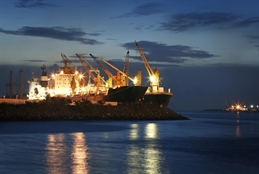
Port Louis in Mauritius proposes to deal with the many challenges it faces, including Covid-19, by underscoring its role as a transhipment hub, its officials told a recent Transport Events webinar.
“Given that Mauritius is heavily dependent on imports and exports, the resulting slowdown in economic activities worldwide has induced a decreasing pattern in captive traffic; hence, the need is felt to consolidate Port Louis’ position as a container transhipment hub,” Ramalingum Maistry, chairman of the Mauritius Ports Authority in Port Louis, told the webinar.
This also allows the port to leverage off its south Indian Ocean location and frequent and regular shipping services to East Africa and Asia.
The MPA is relying on the argument that containers will have a hard time recovering from the pandemic, making earnings volatile. Officials believe this will give the port a two-year timeline; they will also rely on what Maistry called “forward-thinking measures aimed at improving port productivity, [which] can help us improve our overall adaptive capacity in boosting transhipment and engender growth in the container sector.”
These measures include infrastructure and software measures, with the latter being closer to implementation. The port, for example, is close to bringing in a Maritime Single Window System, which will tackle the issue arising from the non-harmonized, multiple systems currently being used.
“The contract would be awarded soon and the project is expected to be completed within eight months,” said Maistry.
Backing this up is an interactive Digital Port Industry Platform, which aims to boost business by transforming the port via enhanced communication services.
Port Louis is also putting in some serious new infrastructure in the form of the Island Terminal Project (ITP) to help it deal with the extra containers it hopes to move in the future. “We have to cater for the volume beyond 2030,” Shakeel Goburdhone, deputy director-general of the MPA, told the webinar.
Currently, Port Louis moves 650,000 TEUs, which it believes will rise to 1 million TEUs in 2025 and 1.9 million TEUs in 2040. “By 2030, it should be doing 1.3 million,” said Goburdhone. These numbers required expansion of the current – rather simple – structure.
What Port Louis is proposing with the ITP is a 1.6-kilometer breakwater connected to the mainland via an access bridge. The land behind this will be reclaimed to give berthage of 1.2 kilometres and 50 hectares of yard.
At the same time, the channel will be deepened to 18 metres from 16.5 metres. This, officials say, will increase capacity to 1.5 million, or maybe even 1.8 million, TEUs.
The other advantage the project brings is ending the swell problem on the other terminal, thereby raising overall productivity.
“Downtime will be reduced by 50%,” said Goburdhone.
Trouble is it was stilled by the pandemic last year although the hope is this year it will start to move.
“The situation is getting back to normal and it is now planned to revive the Island Terminal,” said Goburdhone, adding that the MPA hopes to appoint a transaction advisor this year. Previously it has said the project will cost an estimated US$835 million.
Good as all these sounds, other speakers pointed out that other issues still need to be tackled. One issue looming large here is productivity, both specifically in Port Louis but also regionally.
Port Louis’s productivity is off-target, Khadeeja Oozeerally-Luckhun, managing director of Maersk Mauritius, said, reporting that it makes only 86.69% of its internally set targets.
One particular problem is the “struggling” performance of smaller size vessels, she said, pointing out that Port Louis meets only 88% of its target in this category with 23 moves per hour, while Madagascar hits 119% with 44 moves per hour.
“There is definitely room for improvement here,” Oozeerally-Luckhun said.
Guillaume Hugnin, president of the Mauritius Chamber of Commerce and Industry, acknowledged other problems, alongside what progress has been made. The example he gave is sailings to the Comoros Islands, which can be delayed for up to two even three weeks.
This is a significant problem throughout southern Africa, with “poor integration with other modes of transport and slow clearance by regulatory bodies,” Ken Poonoosamy, CEO of the Economic Development Board of Mauritius, said. This is especially true in the large and already moving markets of Mozambique, Tanzania, and Kenya, he added.
Hugnin was opaque about what caused delays, mentioning inefficient use of cranes, the lack of data, the weather and “external issues” including the Port Authority’s dual role as both landlord and regulator and how to organize private sector involvement in the port.
By Michael Mackey
Correspondent | Bangkok



